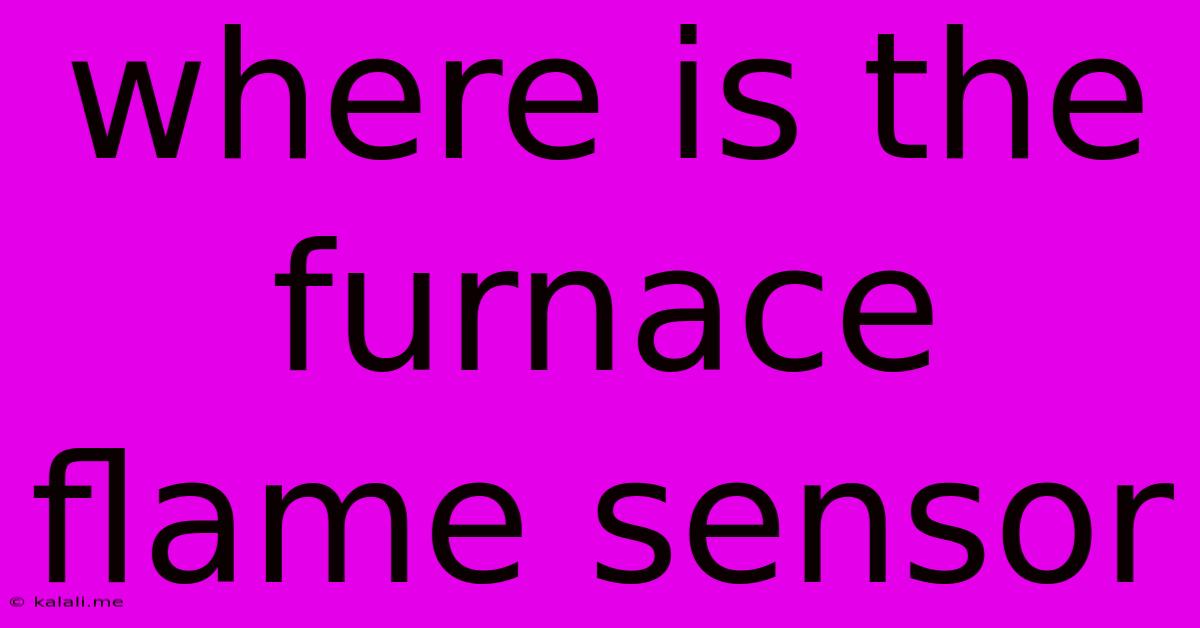Where Is The Furnace Flame Sensor
Kalali
Jun 11, 2025 · 3 min read

Table of Contents
Where Is the Furnace Flame Sensor? A Comprehensive Guide
Finding your furnace's flame sensor can seem daunting, but understanding its location is crucial for troubleshooting common heating issues. A malfunctioning flame sensor can lead to your furnace shutting down unexpectedly, leaving you in the cold. This guide provides a detailed explanation of where to locate this vital component, along with safety precautions and important considerations. Knowing its location can save you time and money on potential repair calls.
Understanding the Furnace Flame Sensor
Before we dive into locations, let's quickly understand the flame sensor's function. This small, rod-like component is typically made of a metal like stainless steel or ceramic. Its purpose is to detect the presence of a flame during the furnace's ignition sequence. If the sensor doesn't detect a flame, it signals the furnace to shut down, preventing gas leaks and potential hazards. A dirty or faulty flame sensor can prevent your furnace from operating correctly.
Common Furnace Flame Sensor Locations
The exact location of the flame sensor varies slightly depending on the make and model of your furnace. However, it's generally found in one of these areas:
-
Near the Burners: This is the most common location. The sensor is positioned close to the gas burners, allowing it to directly monitor the flame's presence. You'll often find it mounted on the burner assembly itself, or on a nearby bracket. Look closely at the area surrounding the igniter and burners.
-
On the Heat Exchanger: Some furnaces have the flame sensor located on the heat exchanger, a metal structure that transfers heat from the burner to the air. This placement allows for monitoring the overall combustion process.
-
Within the Burner Compartment: Often, the sensor is mounted within the main burner compartment. Access may require removing a panel or access door to the furnace interior.
Important Note: Always turn off the power to your furnace at the breaker box before attempting to locate or inspect the flame sensor. Working with gas appliances requires caution and safety should be your top priority.
Identifying the Flame Sensor
The flame sensor is usually a relatively small component, often a metal rod (stainless steel or ceramic) with a wire connected to it. It may be cylindrical or have a slightly different shape depending on your furnace model. It might be labeled, but it's not always clearly marked.
Visual Inspection and Cleaning
Once located, visually inspect the flame sensor for any signs of damage, such as cracks, corrosion, or excessive soot buildup. A dirty flame sensor is a common cause of malfunction. You can usually clean it with fine-grit sandpaper or a wire brush. Always refer to your furnace's owner's manual for specific cleaning instructions. Excessive cleaning can damage the sensor.
When to Call a Professional
If you're uncomfortable working with your furnace, or if you've cleaned the sensor and the problem persists, it's best to call a qualified HVAC technician. A professional can properly diagnose the issue and ensure your furnace is operating safely and efficiently. They have the expertise to handle potential gas leaks and electrical hazards.
This guide provides a comprehensive overview of where to find your furnace's flame sensor. Remember to prioritize safety and consult your owner's manual or a qualified professional if you're unsure about any step. By understanding the location and function of this vital component, you can contribute to the efficient and safe operation of your heating system.
Latest Posts
Latest Posts
-
Which Of The Following Has The Highest Albedo
Jun 12, 2025
-
Authorization Letter For Someone To Pick Up Documents
Jun 12, 2025
-
Polar Moment Of Inertia For Rectangle
Jun 12, 2025
-
What Is The Mountain Range That Separates Europe And Asia
Jun 12, 2025
-
How To Spell The Number 90
Jun 12, 2025
Related Post
Thank you for visiting our website which covers about Where Is The Furnace Flame Sensor . We hope the information provided has been useful to you. Feel free to contact us if you have any questions or need further assistance. See you next time and don't miss to bookmark.